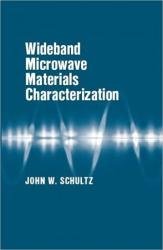Wideband Microwave Materials Characterization
- Добавил: literator
- Дата: 13-05-2023, 01:44
- Комментариев: 0
 Название: Wideband Microwave Materials Characterization
Название: Wideband Microwave Materials CharacterizationАвтор: John W. Schultz
Издательство: Artech House
Год: 2023
Страниц: 331
Язык: английский
Формат: pdf (true)
Размер: 14.3 MB
This book is a practical engineering guide to microwave material measurements for both laboratory and manufacturing/field environments, including nondestructive inspection (NDI) and nondestructive evaluation (NDE). The book covers proven methods for characterizing materials at microwave frequencies, including both resonant and wide-bandwidth techniques, and gives you the necessary theory and equations for implementing these methods. You’ll understand how to invert dielectric and/or magnetic material properties from free space transmission and reflection, and how to measure traveling wave attenuation. You’ll also know how to measure dielectric and/or magnetic material properties from transmission line fixtures and learn how to use computational electromagnetic modeling with a measurement fixture. The book shows you how to build and use microwave NDE equipment for radomes and/or structural dielectric materials. This is an excellent resource for Engineers/scientists conducting or analyzing RF/Microwave/MMW material measurements for applications in electromagnetic materials, as well as those who are developing or applying microwave non-destructive evaluation (NDE) methods to their manufacturing problems.
A number of methods exist for characterizing materials at RF and microwave frequencies, including both resonant and wide-bandwidth techniques. These different techniques are like tools in a toolbox, and each has its advantages and disadvantages. However, this book focuses on the wideband, non-resonant methods as they are applicable to the widest range of materials and are often more practical to use in nonlaboratory environments. The most versatile of the wideband material measurement methods are the free-space techniques. Chapter 2 describes not only the various configurations for free-space measurements, but also provides guidance on calibration methods and signal processing. Chapter 2 also covers the different methods for extracting dielectric and magnetic properties, including the necessary equations for implementing these methods. Next, Chapter 3 explains the use of microwave nondestructive evaluation (NDE) methods including probe design. Chapter 3 also gives an in-depth look into applications such as thickness determination or defect detection.
The interaction of electromagnetic waves in real-world applications often includes concepts around scatter. Chapter 6 is devoted to free-space methods for characterizing scatter whether from inhomogeneous materials or structures. Related to electromagnetic scatter is the concept of surface-traveling waves, which is a phenomenon related to the propagation of energy around a body or component. Understanding surface-traveling waves is necessary in the field of radar detection and cross-section reduction. The theory of traveling wave phenomena along with methods and techniques for evaluating traveling wave effects on materials are also discussed in Chapter 6.
Chapter 5 covers wideband guided-wave methods such as rectangular waveguide, coaxial airline, and stripline transmission line fixtures. Going beyond conventional waveguide methods, Chapter 7 discusses a newer method for material property determination called computational electromagnetic (CEM) inversion. Finally, Chapter 8 describes impedance analysis methods such as dielectric spectroscopy and magnetic permeameter devices.
Скачать Wideband Microwave Materials Characterization
[related-news] [/related-news]
Внимание
Уважаемый посетитель, Вы зашли на сайт как незарегистрированный пользователь.
Мы рекомендуем Вам зарегистрироваться либо войти на сайт под своим именем.
Уважаемый посетитель, Вы зашли на сайт как незарегистрированный пользователь.
Мы рекомендуем Вам зарегистрироваться либо войти на сайт под своим именем.
